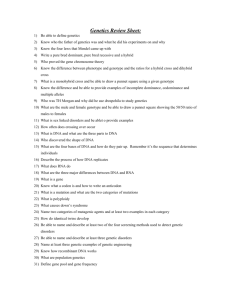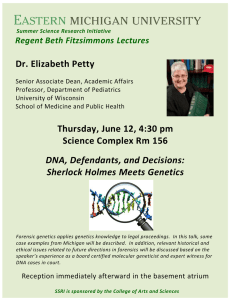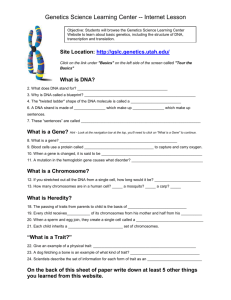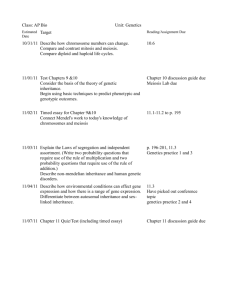El Paso Community College Syllabus Part II Official Course Description
advertisement
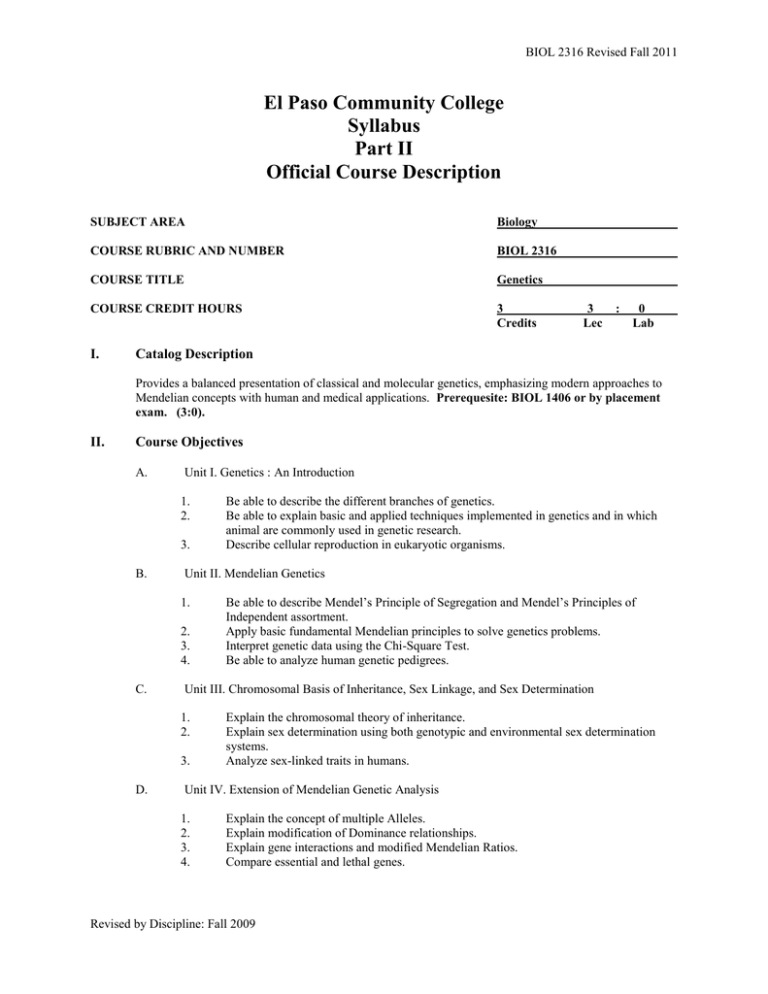
BIOL 2316 Revised Fall 2011 El Paso Community College Syllabus Part II Official Course Description SUBJECT AREA Biology COURSE RUBRIC AND NUMBER BIOL 2316 COURSE TITLE Genetics COURSE CREDIT HOURS 3 Credits I. 3 Lec : 0 Lab Catalog Description Provides a balanced presentation of classical and molecular genetics, emphasizing modern approaches to Mendelian concepts with human and medical applications. Prerequesite: BIOL 1406 or by placement exam. (3:0). II. Course Objectives A. Unit I. Genetics : An Introduction 1. 2. 3. B. Unit II. Mendelian Genetics 1. 2. 3. 4. C. Be able to describe Mendel’s Principle of Segregation and Mendel’s Principles of Independent assortment. Apply basic fundamental Mendelian principles to solve genetics problems. Interpret genetic data using the Chi-Square Test. Be able to analyze human genetic pedigrees. Unit III. Chromosomal Basis of Inheritance, Sex Linkage, and Sex Determination 1. 2. 3. D. Be able to describe the different branches of genetics. Be able to explain basic and applied techniques implemented in genetics and in which animal are commonly used in genetic research. Describe cellular reproduction in eukaryotic organisms. Explain the chromosomal theory of inheritance. Explain sex determination using both genotypic and environmental sex determination systems. Analyze sex-linked traits in humans. Unit IV. Extension of Mendelian Genetic Analysis 1. 2. 3. 4. Explain the concept of multiple Alleles. Explain modification of Dominance relationships. Explain gene interactions and modified Mendelian Ratios. Compare essential and lethal genes. Revised by Discipline: Fall 2009 BIOL 2316 Revised Fall 2011 E. Unit V. Chromosomal Mutations 1. 2. 3. F. Unit VI. Gene Control of Proteins 1. 2. 3. 4. G. Explain the chemical and molecular structure of proteins. Define the nature of the genetic code. Define protein sorting in the cell. Unit XII. Cloning and Manipulating Cloning 1. 2. 3. 4. 5. 6. M. Explain the concept of gene expression. Discuss in full the process of transcription eukaryotic organisms. Unit XI. Gene Expression: Translation 1. 2. 3. L. Discuss in full DNA replication. Discuss DNA recombination. Discuss the significance of screening procedures for the isolation of mutants. Unit X. Gene Expression: Transcription 1. 2. K. Describe and contrast the chromosomes of bacteria, archaea, and viruses. Describe eukaryotic chromosomes and be able to distinguish between their uniquesequence and repetitive- sequence DNA. Unit IX. DNA Replication 1. 2. 3. J. Discuss the experimentation that lead to the discovery that DNA was the genetic material. Be able to discuss the genetic composition of DNA and RNA. Unit VIII. DNA: Organization in Chromosomes 1. 2. I. Be able to explain how genes control enzyme structure. Apply how genetically based enzyme deficiencies relate clinically to human diseases. Describe how genes control the structure of proteins. Apply basic concepts to everyday life = Genetic Counseling. Unit VII. DNA. The Genetic Material 1. 2. H. Discuss the different type of chromosomal mutations. Explain variations in chromosome structure. Explain the clinical significance of variations in chromosomes number. Discuss DNA cloning. Explain the different types of recombinant DNA libraries. Explain how to find a specific clone in a library. Analyze gene and genes transcripts. Describe the polymerase chain reaction (PCR). Discuss ethical issue in genetics. Unit XIII. Regulation of Gene Expression in Bacteria and Bacteriophages 1. 2. 3. 4. Discuss the lac operon of E. coli. Describe lactose as a carbon source for E. coli. Describe the experimental evidence for the regulation of the lac genes. Explain Jacob and Monod’s Operon Model for the regulation of the lac genes. Revised by Discipline: Fall 2009 BIOL 2316 Revised Fall 2011 5. 6. 7. 8. 9. N. Unit XIV. Eukaryotic Gene Regulation 1. 2. 3. 4. 5. O. Explain how transcription is controlled. Explain how protein degradation is controlled. Explain the constancy of DNA in the genome during development. Discuss different gene activity among tissues and during development. Discuss immunogenetics and chromosomes rearrangements during development. Unit XV. Genetics of Cancer 1. 2. 3. III. Explain positive control of the lac operon. Discuss the regulation of the trp Operon. Explain early transcription events. Describe the Lysogenic pathway. Describe the Lytic pathway. Discuss the multi-step of cancer. Describe the role of chemical carcinogens. Describe the control of radiation in the development of cancer. Evaluation A. Objective and short objective exams B. Grading will not follow current El Paso Community College catalog standards. 90-100 80-89 70-79 60-69 Below 60 IV. = = = = = A B C D F Disability Statement (American with/Disabilities Act [ADA]) EPCC offers a variety of services to persons with documented sensory, mental, physical, or temporary disabling conditions to promote success in classes. If you have a disability and believe you may need services, you are encouraged to contact the Center for Students with Disabilities to discuss your needs with a counselor. All discussions and documentation are kept confidential. Offices located: VV Rm C-112 (831-2426); TM Rm 1400 (831-5808); RG Rm B-201 (831-4198); NWC Rm M-54 (831-8815); and MDP Rm A-125 (831-7024) V. 6 Drop Rule Students who began attending Texas public institutions of higher education for the first time during the Fall 2007 semester or later are subject to a 6-Drop limit for all undergraduate classes. Developmental, ESL, Dual Credit and Early College High School classes are exempt from this rule. All students should consult with their instructor before dropping a class. Academic assistance is available. Students are encouraged to see Counseling Services if dropping because exemptions may apply. Refer to the EPCC catalog and website for additional information. Revised by Discipline: Fall 2009




